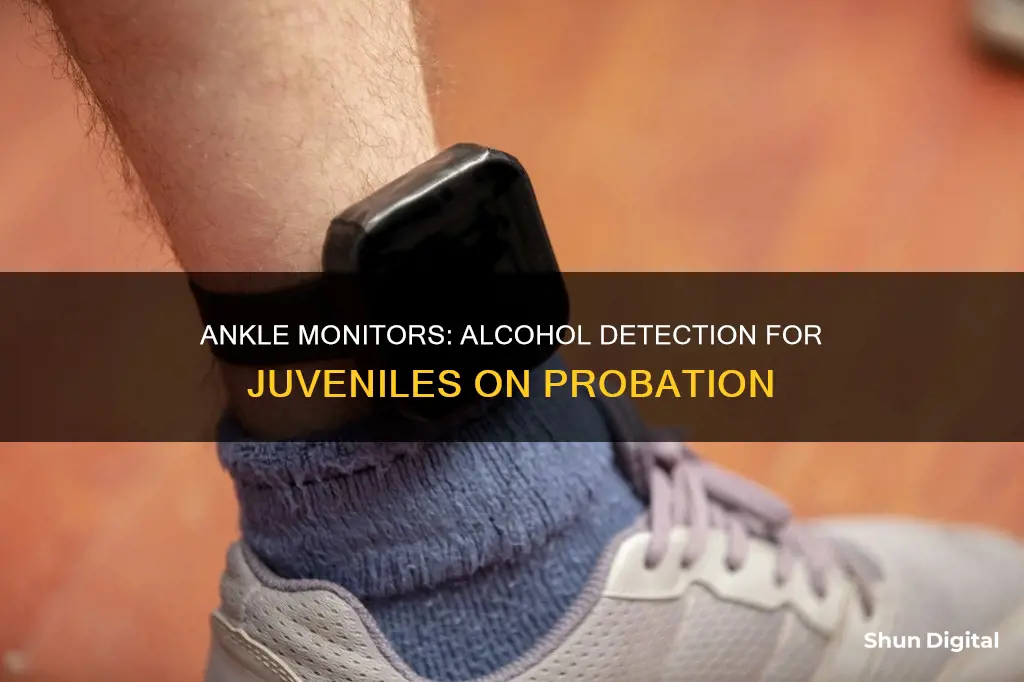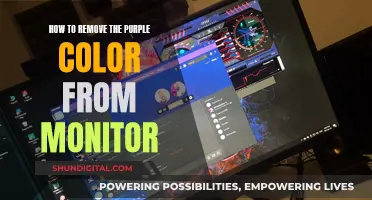
Juvenile ankle monitors are electronic devices that track an individual's movements and activities. While the primary purpose of these monitors is location tracking, some devices have additional features such as alcohol detection. Ankle monitors with alcohol-sensing capabilities, known as SCRAM (Secure Continuous Remote Alcohol Monitor) bracelets, are equipped with advanced technology to detect alcohol consumption through an individual's sweat. These devices sample the wearer's perspiration every 30 minutes, transmitting the data to a monitoring centre which alerts authorities if alcohol is detected. While SCRAM bracelets are highly sensitive and accurate, false positives can occasionally occur due to equipment malfunction or certain medical conditions.
What You'll Learn
- How do juvenile ankle monitors work?
- What happens if you try to remove a juvenile ankle monitor?
- Can you drink alcohol with a juvenile ankle monitor on?
- What happens if you drink alcohol with a juvenile ankle monitor on?
- What are the consequences of drinking alcohol while wearing a juvenile ankle monitor?

How do juvenile ankle monitors work?
Juvenile ankle monitors are typically used to enforce curfews and restrict the wearer's movements to certain areas. They are often used as an alternative to juvenile detention, allowing young offenders to attend school and maintain family relationships.
The ankle monitor is a small electronic device that is fitted to the wearer's ankle with a secure cuff. It uses GPS technology to track the wearer's location, and this information is monitored by staff 24/7. If the wearer violates their curfew or leaves a designated area, the monitoring staff will be alerted, and they will attempt to contact the wearer and their parent or guardian. If the wearer does not comply, the monitor can emit a loud siren.
In addition to GPS tracking, some ankle monitors also include alcohol monitoring capabilities. These devices sample the wearer's perspiration every 30 minutes to detect the presence of alcohol. This method of alcohol detection is known as transdermal alcohol testing, as it measures the ethanol vapour escaping through the skin. The data is transmitted wirelessly to a monitoring centre, and if alcohol consumption is detected, the offender's probation officer is notified.
While juvenile ankle monitors are intended to support rehabilitation and reduce recidivism, there are concerns about their effectiveness. Some young people view the monitors as a status symbol, and they can disrupt education and other activities due to their strict curfew requirements. There is also the potential for false positives with alcohol-detecting monitors, as they can be triggered by alcohol-based products like perfume or hand sanitiser.
Removing the Base from Your DellSE2216H Monitor: A Step-by-Step Guide
You may want to see also

What happens if you try to remove a juvenile ankle monitor?
Ankle monitors, such as the SCRAM CAM bracelet, are equipped with anti-tamper technology that can identify circumvention attempts. If someone tries to remove a juvenile ankle monitor, the regional monitoring centre will be alerted immediately. This will result in a probation violation, which can lead to harsh sentencing or a longer probation period.
The consequences of trying to remove a juvenile ankle monitor can vary depending on the individual's case and the jurisdiction. In some cases, attempting to remove or destroy the device may result in stricter punishments, such as extended probation or additional fines. It is important to note that these devices are designed to be challenging to remove, and any effort to trick or break them is usually futile as the service provider and probation officer will be notified.
The sensitivity of SCRAM bracelets can vary depending on factors such as the duration of drinking events, the version of the bracelet, and its age. However, they are typically accurate and capable of detecting small amounts of alcohol in the sweat, even below 0.02% blood alcohol concentration (BAC).
It is important to note that the court or probation officer may impose penalties if individuals try to trick the bracelet or interfere with the test results. Additionally, individuals may be responsible for paying the installation and daily monitoring fees associated with the ankle monitor.
Finding Monitor Details: A Comprehensive Guide to Specifications
You may want to see also

Can you drink alcohol with a juvenile ankle monitor on?
Juvenile ankle monitors are electronic devices used to monitor the movements and activities of young individuals who are either serving their sentences or are on probation. These monitors are designed to track location and movement using GPS and RF technologies, ensuring that the wearer complies with the rules and restrictions set by the court. While they are highly effective in tracking location and movement, a common question that arises is whether these monitors can detect alcohol consumption.
The simple answer is no. Juvenile ankle monitors are not equipped with alcohol-detecting sensors or breathalyzers. They are designed solely to track location and ensure that individuals abide by their confinement or probation rules. So, if a juvenile is on house arrest, the monitor will keep an eye on whether they stay within the permitted boundaries of their home.
However, it is important to note that there are separate alcohol monitoring ankle bracelets designed specifically to detect alcohol consumption. These bracelets, known as SCRAM (Secure Continuous Remote Alcohol Monitor) bracelets, are often court-ordered for individuals who are not supposed to be drinking alcohol, such as DUI offenders or those with alcohol-related charges. These bracelets work by testing the wearer's perspiration every 30 minutes to detect the presence of alcohol.
So, while juvenile ankle monitors themselves do not detect alcohol consumption, there are specialized alcohol monitoring bracelets that can be used for this purpose. If a juvenile is required to wear an alcohol monitoring bracelet, it is crucial that they abstain from consuming alcohol to avoid legal repercussions.
In conclusion, juvenile ankle monitors are not designed to detect alcohol consumption. Their primary function is to track location and movement. However, separate alcohol monitoring bracelets, such as SCRAM bracelets, are available and can be court-ordered for individuals who need to abstain from alcohol.
Ankle Monitors: Surveillance and Freedom in Question
You may want to see also

What happens if you drink alcohol with a juvenile ankle monitor on?
Juvenile ankle monitors, also known as electronic monitoring devices (EMDs), are commonly used to monitor the movements and activities of young individuals who are either serving their sentences or are on probation. These devices are designed to track and record location data, ensuring that the wearers comply with the terms of their confinement or probation.
Now, to answer the burning question: no, an ankle monitor cannot detect alcohol consumption. These monitors are not equipped with alcohol-detecting sensors or breathalysers. Their primary function is to ensure that the wearer abides by the rules and restrictions imposed by the court, such as house arrest or curfew.
However, there is an advanced type of ankle monitor called the SCRAM CAM® bracelet, which is specifically designed for alcohol monitoring. This device tests the wearer's perspiration every 30 minutes to detect the presence of alcohol. It provides 24/7 transdermal alcohol testing and is usually ordered by a court for DUI offenders or individuals with alcohol-related problems.
If a juvenile is required to wear a SCRAM bracelet and consumes alcohol, the monitoring company will be alerted and will report it to the court or the probation department. This will likely result in severe consequences for the juvenile, such as termination of probation, jail time, or other penalties. Therefore, it is highly recommended to abstain from consuming alcohol while wearing any type of ankle monitor to avoid legal repercussions.
In conclusion, while standard juvenile ankle monitors cannot detect alcohol, the specialised SCRAM bracelet can. Drinking alcohol while wearing a SCRAM bracelet will result in alerts and notifications to the relevant authorities, leading to potential legal consequences for the juvenile offender.
Connecting an LCD Monitor to Raspberry Pi Directly
You may want to see also

What are the consequences of drinking alcohol while wearing a juvenile ankle monitor?
Juvenile ankle monitors, also known as electronic monitoring devices (EMDs), are commonly used to monitor the movements and activities of individuals who are either serving their sentences or are on probation. These devices are designed to track and record location data, ensuring that the wearer complies with the terms of their confinement or probation. While EMDs are primarily designed to track location and movement, some EMDs are capable of alcohol monitoring.
So, what are the consequences of drinking alcohol while wearing a juvenile ankle monitor? If you are required to wear an ankle monitor that is capable of alcohol monitoring, it is essential to understand that drinking alcohol while wearing the device can result in serious consequences. Here are some of the possible outcomes:
- Violation of Probation or Parole Terms: Drinking alcohol while wearing a juvenile ankle monitor that detects alcohol would be considered a violation of the terms set by the court. This could lead to further legal repercussions, including extended probation or parole, additional restrictions, or even jail time.
- Notification of Authorities: Ankle monitors with alcohol-monitoring capabilities, such as the SCRAM (Secure Continuous Remote Alcohol Monitor) system, will detect the presence of alcohol in the wearer's perspiration. This information is transmitted to a private company that monitors the device, and they will notify the court or the probation department.
- Tampering Charges: Attempting to remove or tamper with the ankle monitor to avoid alcohol detection is a serious offence. The monitoring company will be immediately alerted, and such actions can result in severe consequences, including termination of probation, jail time, or other penalties imposed by the court.
- Financial Burden: In addition to legal repercussions, there may be financial consequences as well. Wearing an ankle monitor typically incurs installation fees and daily monitoring charges, which are often the responsibility of the offender.
- Impact on Rehabilitation: Drinking alcohol while on probation or parole demonstrates a lack of compliance with the court-ordered rehabilitation program. This can negatively affect the individual's progress and may lead to extended or more stringent rehabilitation requirements.
- Loss of Privileges: Depending on the specific case and the court's decision, drinking alcohol while wearing a juvenile ankle monitor may result in the loss of certain privileges. This could include restrictions on movement, increased supervision, or limitations on social activities.
- Increased Surveillance: To ensure compliance, authorities may increase surveillance and monitoring of the individual. This could involve more frequent check-ins, drug and alcohol testing, or stricter supervision by a probation officer.
It is important to note that the consequences may vary depending on the jurisdiction, the nature of the offence, and the specific terms set by the court. It is always advisable to abide by the conditions set by the court and seek legal assistance if needed.
Finding the Elusive X and Y on Your Monitor
You may want to see also
Frequently asked questions
SCRAM stands for Secure Continuous Remote Alcohol Monitor. It is an alcohol detector in the form of an ankle bracelet that is court-ordered for DUI offenders.
The SCRAM ankle monitor tests the wearer's perspiration or sweat every 30 minutes for the presence of alcohol. This is known as transdermal alcohol concentration.
If you try to remove a SCRAM ankle monitor, the monitoring company will be alerted immediately and this information will be reported to the court or probation department. Tampering with a SCRAM bracelet can lead to severe consequences such as jail time or termination of probation.
There is an installation fee ranging from $50 to $100 and a daily monitoring fee ranging from $10 to $15. The monthly cost of wearing a SCRAM bracelet can be up to $300 or more.
Yes, SCRAM ankle monitors are highly sensitive and can detect even small amounts of alcohol in the system. It is recommended to abstain from consuming alcohol while wearing a SCRAM bracelet.







